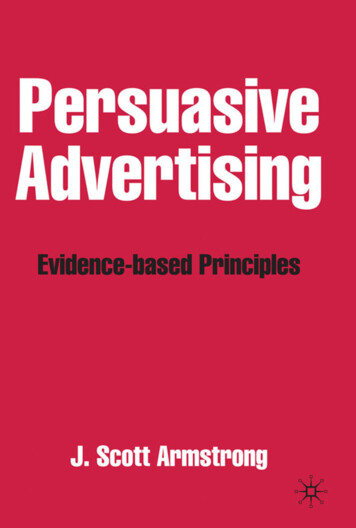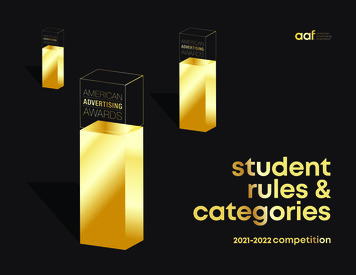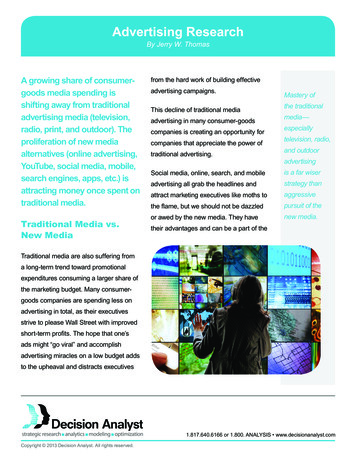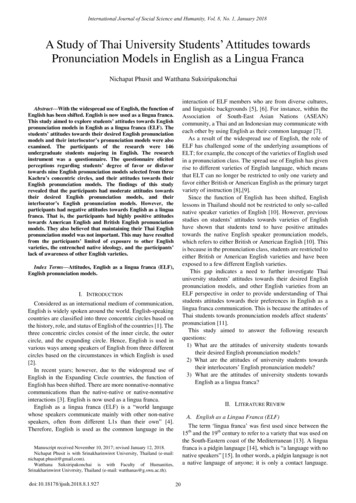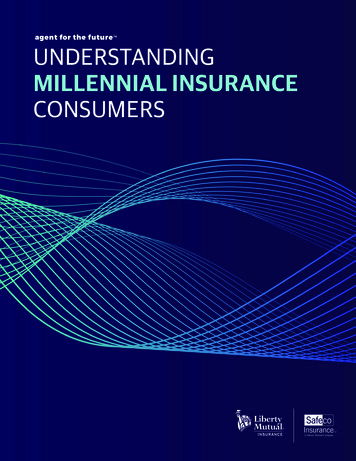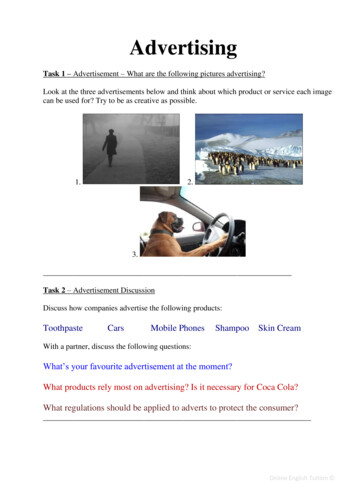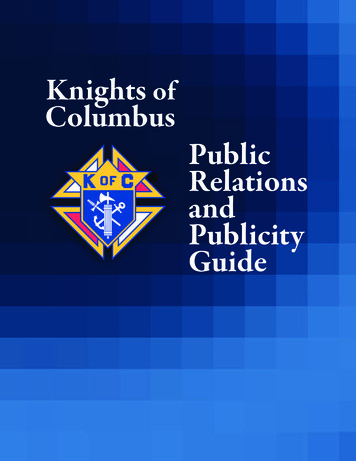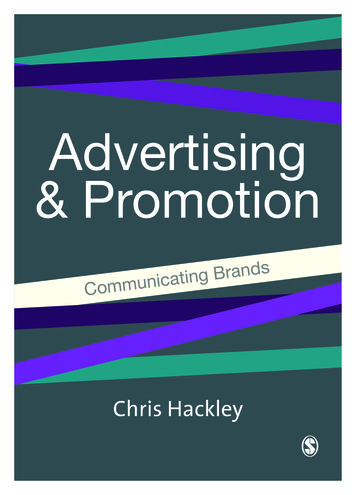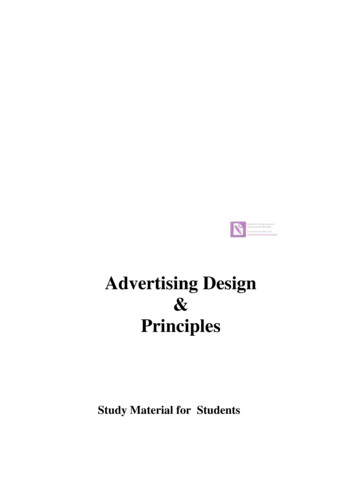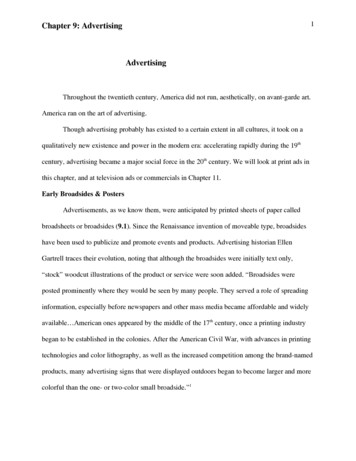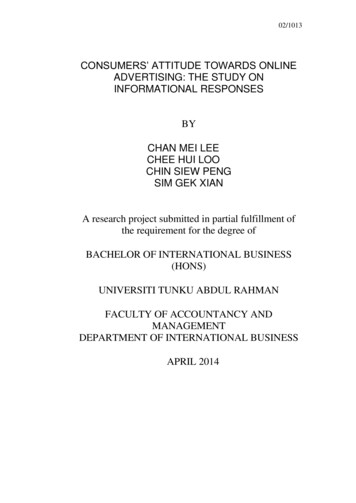
Transcription
02/1013CONSUMERS’ ATTITUDE TOWARDS ONLINEADVERTISING: THE STUDY ONINFORMATIONAL RESPONSESBYCHAN MEI LEECHEE HUI LOOCHIN SIEW PENGSIM GEK XIANA research project submitted in partial fulfillment ofthe requirement for the degree ofBACHELOR OF INTERNATIONAL BUSINESS(HONS)UNIVERSITI TUNKU ABDUL RAHMANFACULTY OF ACCOUNTANCY ANDMANAGEMENTDEPARTMENT OF INTERNATIONAL BUSINESSAPRIL 2014
Copyright @ 2014ALL RIGHTS RESERVED. No part of this paper may be reproduced, storedin a retrieval system, or transmitted in any form or by any means, graphic,electronic, mechanical, photocopying, recording, scanning, or otherwise,without the prior consent of the authors.ii
DECLARATIONWe hereby declare that:(1) This undergraduate research project is the end result of our own work andthat due acknowledgement has been given in the references to ALLsources of information be they printed, electronic, or personal.(2) No portion of this research project has been submitted in support of anyapplication for any other degree or qualification of this or any otheruniversity, or other institutes of learning.(3) Equal contribution has been made by each group member in completingthe research project.(4) The word count of this research report is 17674,Name of Student:Student ID:Signature:1. CHAN MEI LEE12UKB067852. CHEE HUI LOO12UKB077233. CHIN SIEW PENG12UKB073604. SIM GEK XIAN13UKB00380Date: 18 April 2014ii
ACKNOWLEDGEMENTSFirstly, we would like to acknowledge, with gratitude, our debt of thanks to ourresearch project supervisor, Mr. Alexander Tay Guan Meng for his valuableadvice and aid. Working under his guaidance make us learn much. Without hisexpert and great insightful advice, we could not have finished this thesis researchin time.Besides, we are thankful to all the respondents who had spent their precious timein answering our questionnaires. Without their cooperation and contribution wewill not have the oppurtunity to ontain the information needed in completing theresearch.In addition, we would like to express our appreciation to the facilities thatUniversity Tunku Abdul Rahman has provided. Without these facilities, we wouldnot able to make this research project a success.We also take this oppurtunity to record our sincere thanks to all our family andfriends for their unceasing uncouragement, help and support.We also place on record, our sense of graditude to one and all who, directly orindirectly, have lent their helping hand in this venture. We truly appreciate theassistance, encouragement, advices, and suggestions on every stage in completingthis project.Thank You.iii
DEDICATIONWe would like to dedicate this dissertation mainly to our parents and friends fortheir valuable support, encouragement and helping hands. Next, we would alsolike to dedicate our research to our supervisor, Mr. Alexander Tay Guan Meng,who provides insightful feedbacks, assistance, motivation, guidance and kindunderstanding for us.iv
TABLE OF CONTENTSPageCopyright Page .iiDeclaration iiiAcknowledgement ivDedication .vTable of Contents .viList of Tables xiList of Figures .xiiList of Appendices .xiiiPreface .xivAbstract .xvCHAPTER 1INTRODUCTION .11.1Research Background .11.2Problems Defination 41.3Research Objectives .51.3.1 General Objective .51.3.2 Specific Objective .51.4Research Questions .61.5Hypothesis of the Study .71.6Significance of the Research 71.7Chapter Layout . .91.8Conclusion.10v
CHAPTER 2REVIEW OF LITERATURE . 112.1Review of Literature.112.1.1Attitude toward Online Advertising . .112.1.2Credibility . .142.1.3Informative .162.1.4Hedonic and Pleasure .182.1.5Materialism .202.1.6Informational Responses .222.2Theoretical Framework 242.3Proposed Conceptual Framework 262.4Hypothesis Development .282.4CHAPTER 33.12.4.1The Relationship between Credibility andConsumers’ Attitude towards OnlineAdvertising .282.4.2The Relationship between Informative andConsumers’ Attitude towards OnlineAdvertising .302.4.3The Relationship between Hedonic/Pleasure andConsumers’ Attitude towards OnlineAdvertising . .312.4.4The Relationship between Materialism andConsumers’ Attitude towards OnlineAdvertising .332.4.5The Relationship between Consumers’Attitude towards Online Advertising andInformational Responses .35Conclusion . .37METHODOLOGY .38Research Design .383.1.1Quantitative Research .38vi
3.1.23.2Data Collection Methods .393.2.13.33.43.53.63.7Descriptive Research .39Primary Data .39Sampling Design .403.3.1Target Population 403.3.2Sampling Frame and Sampling Location 413.3.3Sampling Elements .413.3.4Sampling Technique .413.3.5Sampling Size . .42Research Instrument . 423.4.1Questionnaire Survey . 423.4.2Questionnaire Design .433.4.3Pilot Test .43Construct Measurement: Scale of Measurement .443.5.1Nominal Scale . .443.5.2Interval Scale 443.5.3Ratio Scale 453.5.4Origin of Construct .45Data Processing 473.6.1Questionnaire Checking .473.6.2Editing .483.6.3Coding and Transcribing . .483.6.4Data Cleaning .48Data Analysis .493.7.1Descriptive Analysis . 49vii
3.7.2Scale Measurement .493.7.2.13.7.3Reliability .50Inferential Analysis .503.7.3.1 Pearson’s Correlation Analysis 503.7.3.2 Multiple Regression Analysis .513.8CHAPTER 4Conclusion . 52DATA ANALYSIS4.1.14.1.24.2Respondents’ Demographic Profile .534.1.1.1Gender .544.1.1.2Race .554.1.1.3Age .564.1.1.4Education Level . 574.1.1.5Occupation .584.1.1.6Hours per Week Spend Online 594.1.1.7Frequency Click on InternetAdvertisement .60Central Tendencies Measurement ofConstructs 61Scale Measurement .624.2.14.3 .53Reliability test .62Inferential Analyses . .634.3.1Pearson Correlation Analysis . .634.3.2Multiple Regression Analysis .654.3.2.1R square (a) .654.3.2.2Test of significance (a) 66viii
4.3.34.44.3.2.3R square (b) .684.3.2.4Test of Significance (b) .684.3.2.5Regression Equation 69Hypotheses Results . 70Conclusion .71CHAPTER 5:DISCUSSION, CONCLUSION ANDIMPLICATIONS 725.1Summary of Statistical Analyses .725.1.1 Descriptive Analysis . 725.1.2 Scale Measurement .735.1.3 Inferential Analysis .735.1.3.1 Pearson Correlation .735.1.3.2 Multiple Regression Analysis .745.25.3Discussions of Major Findings 755.2.1Informative is Significantly Related toConsumers’ Attitude towards OnlineAdvertising .755.2.2Hedonic/Pleasure is Significantly Related toConsumers’ Attitude towards OnlineAdvertising .755.2.3Materialsim is Significantly Related toConsumers’ Attitude towards OnlineAdvertising .765.2.4Consumers’ Attitude towards OnlineAdvertising is Significantly Related to theInformational Responses .765.2.5Credibility is Significantly Related toConsumers’ Attitude towards OnlineAdvertising .77Implications of the Study .79ix
5.3.1Theoretical Implications .795.3.2Managerial Implications .795.4Limitations of the Study .825.5Recommendations for Future Research .835.6Conclusion 84References .85Appendices .97x
LIST OF TABLESPageTable 1.1: Hypotheses of the study7Table 3.1 Origins of Constructs45Table 4.1: Gender54Table 4.2: Race25Table 4.3: Age56Table 4.4: Education Level57Table 4.5: Occupation58Table 4.6: Hours per week spend online59Table 4.7: How frequent click on internet advertisement60Table 4.8: Descriptive Statistics61Table 4.9: Reliability test (Cronbach’s alpha)62Table 4.10: Correlations Matrix63Table 4.11: Model Summary (a)65Table 4.12: ANOVAa (a)66Table 4.13: Resulted of Multiple Linear Regression AnalysisCoefficientsa (a)67Table 4.14: Model Summary (b)68Table 4.15: ANOVAa (b)68Table 4.16: Resulted of Multiple Linear Regression AnalysisCoefficientsa (b)69Table 5.1: Summary of the Hypotheses Testing Results78xi
LIST OF FIGURESPageFigure 2.1 Theoretical Framework24Figure 2.2: Proposed Conceptual Frameworks26Figure 4.1: Gender54Figure 4.2: Race55Figure 4.3: Age56Figure 4.4: Education Level57Figure 4.5: Occupation58Figure 4.6: Hours per week spend online59Figure 4.7: How frequent click on internet advertisement60xii
LIST OF APPENDICESPageAppendix 1.1: Summary of the key determinants ofconsumers’ attitude towards advertising . 97Appendix 3.1: Questionnaire . .98Appendix 4.1: Frequency of Gender .103Appendix 4.2: Frequency of Race . .104Appendix 4.3: Frequency of Age. . . 105Appendix 4.4: Frequency of Education . 106Appendix 4.5: Frequency of Occupation .107Appendix 4.6: Frequency of Hours per week Spend online .108Appendix 4.7: How Frequent Click on Internet Advertisement . 109Appendix 4.8: Descriptive Statistics . . .110Appendix 4.9 Reliability Test (Cronbach’s alpha) . 111Appendix 4.10: Pearson Correlations Analysis . .112Appendix 4.11: Multiple Regression Analysis (a) . .113Appendix 4.12: Multiple Regression Analysis (b) . 114xiii
PREFACEThe research topic is Consumers’ Attitude towards Online Advertising: The Studyon Informational Responses. Researchers choose this topic to investigate andstudy the predictors that will impact on consumers’ attitude towards onlineadvertising which then subsequently affect their informational responses.Attitude is defined as an overall evaluation that expresses the extent of favor ordisfavor of an individual towards an object, issue, person, idea or action and ittends to be an enduring emotional feeling. Consumers’ attitude towards onlineadvertising is the consumers’ point of view towards online advertisements whichcan be favorable or unfavorable response towards a particular onlineadvertisement. If the consumers’ attitude is more favorable towards onlineadvertisements, then they are most likely would have positive informationalresponses towards it.Thus, there are four variable that consumers will evaluate their experiences in theadvertising. These entire variables play important roles in influencing consumers’attitude towards online advertising.xiv
ABSTRACTCompanies increasingly see Internet advertising as an important medium in reachingout to consumers in 21st Century. The number of Internet users around the worldincluding Malaysia in today’s world are increasing as almost all the transactions canbe done through online. Thus, online advertisers need to understand the consumers’attitude towards online advertising in order to create effective online advertising.The main aim of this research is to study consumers’ attitude towards onlineadvertising and informational responses. This research is to investigate fourindependent variables which comprise credibility, informative, hedonic, andmaterialism that have impact on dependent variable of consumers’ attitude towardonline advertising such as perception, feeling and behavior towards online advertising.Besides, this research study also investigates informational responses which includedawareness, interest, desires and purchase intention towards advertised products.By using the Statistical Packages for Social Science (SPSS) version 20.0 to analyze200 sets of questionnaires collected from the respondents, researchers found that allthe variables expect credibility are significant related to consumers’ attitude towardsonline advertising. Among the independent variables, informative has the strongestsignificant relationship with dependent variable consumers’ attitude towards onlineadvertising. Besides, analysis also shows consumers’ attitude towards onlineadvertising has significant relationship with informational responses.The target population in this research study is internet users who might haveposibility exposure to online advertising. The sampling frame comprises internetusers in the area of Klang Valley with the criteria of frequency click on internetadvertisement is at least one and the hours per week spend online is at least five hours.The limitations and recommendations are discussed with regards to furtherimprovement. As the significant increasing in the number of internet users and usage,thus, it is crucial for advertisers to have a clear picture and understanding ofconsumers’ attitude towards online advertising in order to attract consumers’ attentionwhich will subsequently impact on their informational responses.xv
ATTITUDE TOWARDS ONLINE ADVERTISINGCHAPTER 1: RESEARCH OVERVIEW1.0IntroductionThe topic of this business research study is about consumers’ attitude towardsonline advertising: The study on informational responses. Consumers’ attitudesare about an individual’s personal perception, feelings, behaviour and belieftowards online advertising. The purpose of this research paper is to study thefactors that affect consumers’ attitude towards online advertising and theirinfluence on consumer’s informational responses.In this section, the reportincludes research background, problem definition, research questions and researchobjectives, follow by significance of the research.1.1Research BackgroundAdvertising is defined as a set of communications or activities which deliverinformation to the public by capturing the target consumers’ attention (Ducoffe,1996). It is a paid form of non-personal communication to present and promoteideas, goods or services by an identified sponsor (Kotler, 2000).Online advertising is an advertisement which is published on the internet. This canbe useful in creating awareness of an organisation and its product and services(Abd Aziz, Mohd Yasin, and Syed A. Kadir, 2008). The first online advertisementthat appeared on the web was in year 1994 (Rachel, 2011). Online advertisingincludes many forms of commercial content - from electronic advertisements thatare similar to traditional advertisement to formats that are different fromtraditional advertisements, such as corporate web sites (Ducoffe, 1996). Onlineadvertising consists of a variety of methods including web banner advertising,blog advertising, promotional advertising, social network advertising and so on(Ducoffee, 1996; Schlosser, Shavitt, and Kanfer, 1999).Page 1 of 114
ATTITUDE TOWARDS ONLINE ADVERTISINGNowadays, technology advancement has enabled internet penetration into to everypart of our lives, and we are spending more time on internet (Abd Aziz et al.,2008). This creates high possibilities for an internet user to engage in onlineadvertising. Thus, marketers are able to capture this opportunity to reach theirconsumers via online platforms to create awareness for their products, services,and to increase sales in the future (Abd Aziz et al., 2008).The reason that online advertising attracted more investment from marketers is thehigh benefits. For instance, online advertising is flexible and makes it easier forthe company to update their products’ information immediately (Ducoffe, 1996).This allows the consumers to obtain the latest information about the products andservices that company offer in the market (Ducoffe, 1996).Another point towards online advertising would be its lower costs compared toadvertising via traditional media (Belch and Belch, 1998). Online advertising canreach and cover a larger target audience and geographical areas compared totraditional advertising at a lower cost (Belch and Belch, 1998), hence, proving itsworth in today’s Internet saturated world.Through the internet, marketers are also able to deliver advertising message inmore creative ways. For example, advertisement messages that pop up in theinternet with attractive animations instead of merely words make it easier tocapture a consumer’s attention (Tsang and Tse, 2005). It will surprise and excitethe consumers and allow them to enjoy the advertisement much more compared totraditional outlets.Other than that, through online advertising, marketer are able to interact withcustomers easily as consumers are allow to collect information, participate inproducts design, explore promotions, arrange deliveries, sales and receive postpurchase support (Pavlou and Stewart, 2000). This can aid marketers in increasingtheir understanding on consumers, and thereby generate and manage closerelationships with their clients (Abd Aziz et al., 2008).Page 2 of 114
ATTITUDE TOWARDS ONLINE ADVERTISINGConsumers may form different attitudes towards online advertising. Consumer’sattitude can be defined as the direct human reflection towards the onlineadvertising (Bauer & Greyser, 1968). As mention earlier, consumers’ attitudeincluded behaviour, feeling, and perception. Behaviour is the actions or reactionsof an individual in response to external or internal stimuli (Keller, 1993). Feelingis an emotional state of an individual such as joy, excitement, and displeasure(Mehta, 2000). Perception is the act of perceiving by an individual through seeing,hearing, smelling or touching (Keller, 1993).The attitude of consumers may be influenced by the factors of online advertising,such as credibility, in-formativeness, hedonism/ pleasure and materialism.Credibility is the consumer’s perception towards the credibility, trustworthiness,believability and convincibility of an online advertisement (MacKenzie and Lutz,1989). In-formativeness is consumer perception whether the online advertisementis a valuable resource that provides added value towards the brand and latestinformation in the market (Ducoffe, 1996). Hedonism/ pleasure is an individualmind-set towards online advertising that is enjoyable, pleasurable, and exciting(O’Shaughnessy and Jackson O’Shaughnessy, 2002), surprising and amusing.Materialism is defined as considering material acquisition as an important aspectof life, the pursuit of happiness, and considering number of possessions as acorrelation towards success in life (Richins and Dawson, 1992).Credibility, hedonism/pleasure, in-formativeness and materialism are important inthis research because these four factors are common variables and frequently usedby other researchers in their research topics which are similar to this study. Thesefour factors have shown the strong relationship with the consumers’ attitudetowards online advertising. The table below shows that these four common factorsare frequently supported by other researchers.As consumers formed different attitude towards the online advertisement, this willin turn influence the consumers’ informational responses. Informational responsesare a process that consumers will go thorough when responding to and onlinePage 3 of 114
ATTITUDE TOWARDS ONLINE ADVERTISINGadvertisement (Belch and Belch, 2011). It comprise of four stages which areawareness, interest, desires and action.Marketers face the challenges transition to new media (online advertising) such ascultural changes and management commitment (Malaysian Communications andMultimedia Commission, 2009). Given advancing technology, shifts in consumerconsumption patterns and lifestyles will cause the platforms for communicationsare becoming more complex (Malaysian Communications and MultimediaCommission, 2009). This is a challenge for them. They must have thecommitment to explore and deepen creative content to be in sync with consumers’lifestyle (Malaysian Communications and Multimedia Commission, 2009).Marketers need to adapt to the new wave of technology revolution by shifting toonline advertising in order to stay competitive in their value chain, if not they willlose in the market (Malaysian Communications and Multimedia Commission,2009). If marketers do not infuse innovation and alertness to changes in the mediaenvironment into their business models, they will lose significant revenue toonline advertising (Malaysian Communications and Multimedia Commission,2009).Consumers have control over the advertising exposure as they can select when andhow much commercial content they wish to view (Abd Aziz, Mohd Yasin, andSyed A. Kadir, 2008). Therefore, marketers do not know whether consumers areclicking on a link accidentally or intentionally. This shows that the marketers areunable to exert full control over the exposure of their advertisement on consumers.1.2Problem DefinitionIn this study, consumer’s attitude towards online advertising consist severalresearch gaps. One of the research gaps is lack of literature review of this researchtopic in the context of Malaysia. This has caused researchers to face difficulty inexamining this topic as there is lack of relevant information (Abd Aziz et al.,Page 4 of 114
ATTITUDE TOWARDS ONLINE ADVERTISING2008). Therefore, researchers have to further study this area based on the Malaysiacontext.The Malaysian advertising landscape is gradually shifting its traditional media tothe new media advertising (Malaysian Communications and MultimediaCommissions, 2009). Consumers can select whether, when, and how muchcommercial content they wish to view in an online advertisement (Schlosser et al.,1999). It is all up to the consumers to seek additional commercial content in theonline advertisement (Schlosser et al., 1999). In addition, consumers’ perceptionand attitudes towards online advertising may still evolve over time (Karson,McCloy, and Bonner, 2006), therefore researchers lack of understanding and littleis known in consumer beliefs about online advertising associated with consumerbehaviour in Malaysia (Abd Aziz et al., 2008).1.3Research Objectives1.3.1 General ObjectivesIn general, the research objective is to study about the attitude ofconsumers towards the online advertising. The overall researches consistof four independent variables which include credibility, informative,hedonism/pleasure, and materialism.1.3.2 Specific ObjectivesSpecifically, the objective is to use these four yardsticks to identify andexamine the relationship between consumers’ attitude towards onlineadvertising.Page 5 of 114
ATTITUDE TOWARDS ONLINE ADVERTISING To identify the relationship between the credibility of the onlineadvertisement and consumers’ attitude towards online advertising. To identify the relationship between the in-formativeness and consumers’attitude towards online advertising. To identify the relationship between the hedonism/pleasure and consumers’attitude towards online advertising. To identify the relationship between the materialism and consumers’attitude towards online advertising. To identify the impact of consumers’ attitude towards online advertising ininformational responses.1.4Research QuestionsIn this study, there are five research questions which have been developed asshown below: What are the consumers’ attitudes? Will the credibility of advertising content affect consumers’ attitudetowards online advertising? Will in-formativeness of advertisement messages affect consumers’attitude towards online advertising? Will hedonism/pleasure in advertisement message affect consumers’attitude towards online advertising? Will materialism affect consumers’ attitude towards online advertising? Will consumers’ attitude towards online advertising have an impact oninformational responses?Page 6 of 114
ATTITUDE TOWARDS ONLINE ADVERTISING1.5Hypotheses of the StudyTable 1.1: Hypotheses of the studyH1Credibility is significantly related to consumers’ attitude towards onlineadvertising.H2Informative is significantly related to consumers’ attitude towards onlineadvertising.H3Hedonic/ pleasure is significantly related to consumers’ attitude towardsonline advertising.H4Materialism is significantly related to consumers’ attitude towards onlineadvertising.H5Consumers’ attitude towards online advertising is significantly related toinformational responses.Source: Developed for the research1.6Significance of the ResearchThe reason this topic is chosen is to allow for better understanding of theconsumer’s attitude towards online advertising, so that marketers can effectivelycreate their advertisements via internet. Furthermore, as there is lack of researchstudy of this topic in the Malaysian context, in order to enhance the knowledge inthis field, this research is carried out in Malaysia.Many consumers tend to ignore online advertising because they perceive onlineadvertising as deceiving (Obermiller, Spangenberg, and MacLachlan, 2005). Inthis study, credibility is an essential component of an effective online advertisingas it able to gain confidence of consumers. Therefore, it is advisable for themarketer to increase the believability of advertising by providing truthfulinformation (Eze and Lee, 2012).Page 7 of 114
ATTITUDE TOWARDS ONLINE ADVERTISINGIn order to create product awareness and positive impact over the consumers,online advertising should contain detailed and relevant information in the message(Briggs and Hollis, 1997). This may help consumers easily obtain and retrieve thelatest information about the products available in marketplace (Ducoffe, 1996).Besides, it also allows consumers to make comparisons between products andchoose the one which is suitable for their needs and wants.Entertaining and pleasurable online advertising are able to capture a consumer’sattention. Marketers should ensure that their online advertising is attractive andenjoyable for the consumers as it able to capture consumer’s attentionimmediately and stimulate the consumer’s curiosity to click on the advertisement(Katterbach, 2002). This also increases the possibility that consumers willrecommend the advertisement to others.As consumers live in materialistic society, they demand for material objects andthis race for possession acquisition plays an important part in our social structures(Goldschmidt, 1990), making materialistic individuals motivated to maintain orgain status by buying material objects. Certain degree of self-presentationalconcern is good by buying material objects to enhance one’s self-image(Schlenker, 1980). Therefore, online advertising that promotes a certain degree ofmaterialism should be encouraged because it can boost the economy and increasethe standard of living when individuals continue spending (Watson, 2007).Besides, materialism can also help individuals who tend have low self-esteembecause it can close the gap between individual’s ideal and actual self-image(Dittmar, 2005) which in turn makes them feel good and happy in life.Lastly, creating consumer’s awareness, interest, and desire as well as purchaseintention on company products or services is the objective of many marketers(Bijmolt, Claassen and Brus, 1998). For creating more favourable consumerinformational responses, consumer’s attitude towards online advertising plays animprotant role (James and Terrance, 1992). Thus, it is important for the marketersto understand the factors that contribute in developing a fovarable consumers’attitude towards online advertising. Consumer who preceive online advertisingPage 8 of 114
ATTITUDE TOWARDS ONLINE ADVERTISINGpositively tend to pay more attention to online advertising as well as have higherpurchase intention towards the advertised products and services (Rawal, 2013).1.7Chapter LayoutThe body of the research consists of five chapters as following:In Chapter 1, it is introductory chapter which provides an overview of the study.The introduction of this chapter states the aims and the organization of Chapter 1.This chapter includes research background, problem statement, researchobjectives, research questions, hypotheses of the study, and significance of thestudy. Lastly, the conclusion of this chapter is drawn.In Chapter 2, the introduction and review of the relevant literature and findingsrelated to research topic will be discussed. Reviewing of theoretical models andproposed conceptual framework will be included in this chapter. In addition,hypotheses will be developed once the relationship among the variables has beenestablished in the conceptual framework. Finally, the conclusion of this chapterwill be provided.In Chapter 3, it provides the overview of the research methodology. This chapterincludes research design, data collection methods, sampling design, researchinstrument, constructs management, data processing, and data analysis. Thischapter will be end with the conclusion of the chapter.In Chapter 4, it discusses the patterns of the results and analyses of the resultswhich are related to the research questions and hypotheses. Descriptive analysissuch as respondent demographic profile and central tendencies measurement willbe discussed in this chapter. Besides that, the results of the reliability analysis willbe provided. Inferential analyses will be included to test the individual variablesand its relationships with other va
attitude towards online advertising in order to create effective online advertising. The main aim of this research is to study consumers' attitude towards online advertising and informational responses. This research is to investigate four independent variables which comprise credibility, informative, hedonic, and .
